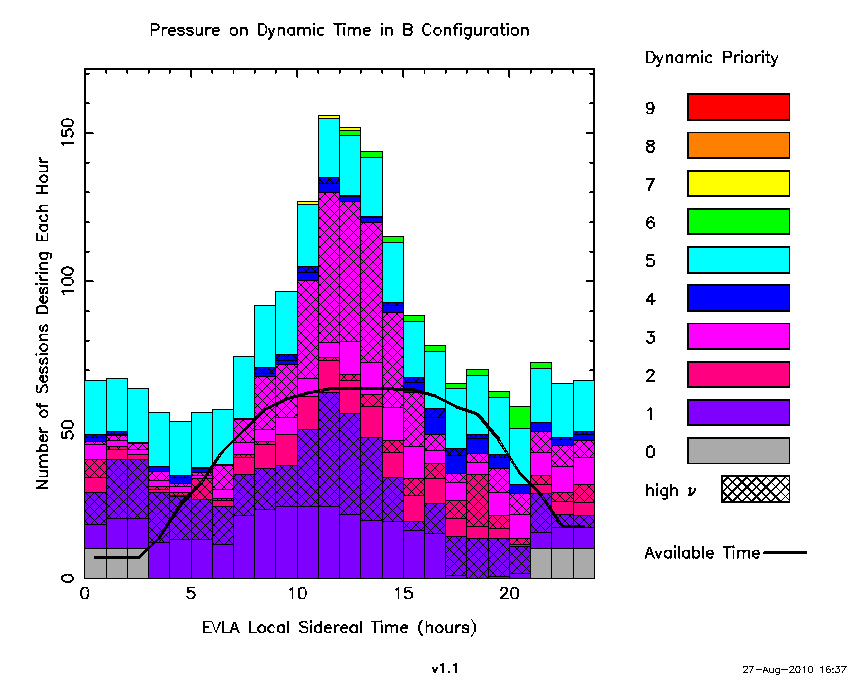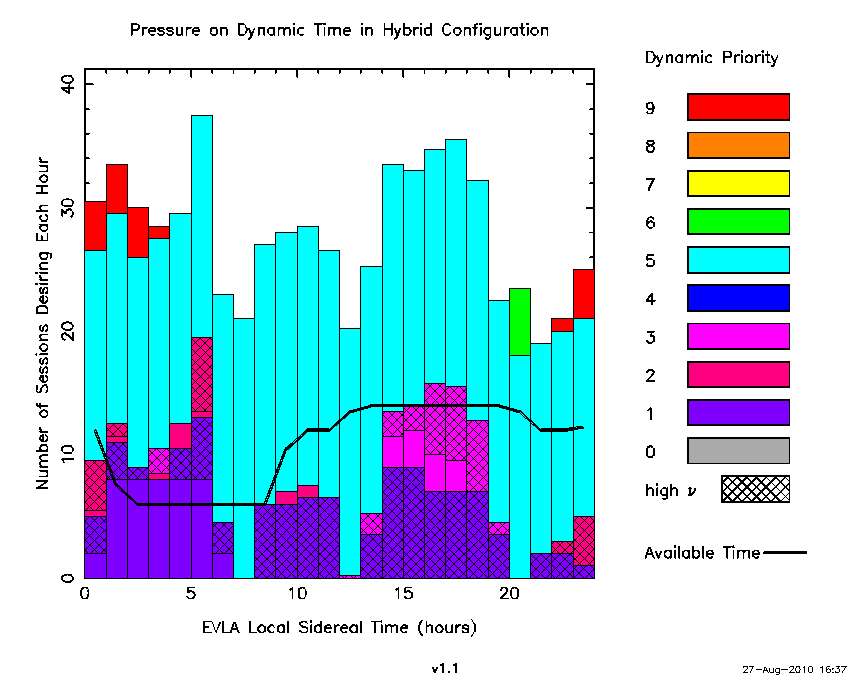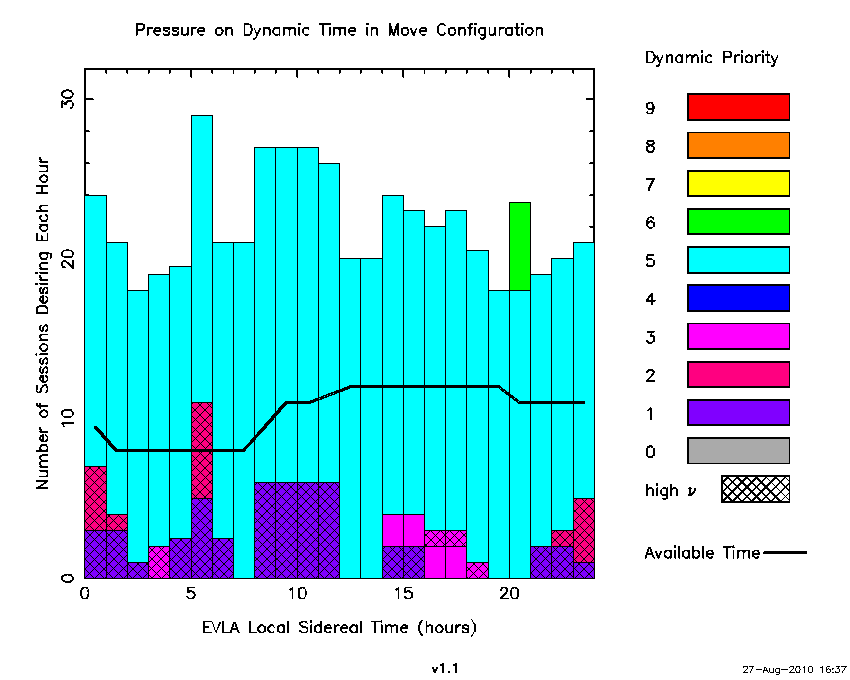Memorandum to EVLA/VLBA Proposers and Observers
News
-
- General announcements and news for investigators
proposing to use the EVLA, VLBA, HSA, and other VLBI facilities for
the 2010 October 1 deadline will be
available in mid-September. A revised EVLA configuration schedule
is
available
Current Regular and Large Proposals
- General
- Information about the status of all
current proposals on which your name appears has been e-mailed to you,
in a format described under Static Information below. That e-mailing
(a) includes proposals just considered for trimester 2010c plus those
waiting for future trimesters, whatever their date of submission; and
(b) does not include proposals submitted earlier that are waiting in
the dynamic scheduling queues.
- EVLA Scheduling
- This can take two forms, dynamic and
fixed date. Rare proposals, particularly those requiring coordination
with other facilities, will be scheduled on fixed dates with
notification to the observers about six weeks in advance. Most
approved proposals will be accepted for insertion into the EVLA
dynamic scheduling queue, at priorities ranging from 0 (highest) to 9
(lowest).
- EVLA Statistics
- There were 123 active EVLA proposals.
We approved 60 proposals for insertion into the EVLA dynamic queue (4
of these were triggered transient proposals). One proposal was
approved for fixed-date time. We rejected 55 proposals. For
trimester 2010c, the ratio of the total time requested to the total
time available was 4.8. A forthcoming eNews article will include
information about approved proposals. The EVLA dynamic queue is
generally oversubscribed. To gauge the pressure on dynamic time as a
function of EVLA LST, consult the pressure histograms below for the B
configuration (February 4 to April 25), the BnA configuration (April
29 to May 16), and the move configurations (January 24 to February 4,
April 25-29). These pressure histograms for trimester 2010c exclude
triggered transient proposals. OSRO restrictions are evolving with
time, so we recommend that trimester 2010c observers wait until
January to prepare their scheduling blocks. We also remind observers
of the shared-risk nature of early science with the EVLA during
trimester 2010c.



- VLBA Scheduling
- This can take two forms, dynamic and
fixed date. Most approved proposals will be accepted for insertion
into the VLBA dynamic scheduling queue, at priority 1 (highest), 2, or
3 (lowest). A Guide to VLBA
Dynamic Scheduling is available. Rare proposals, particularly
those requiring other resources such as a non-VLBA antenna, will be
scheduled on fixed dates with notification to the observers about six
weeks in advance.
- VLBA Statistics
- There were 38 active VLBA
proposals. We approved 16 proposals for insertion into the VLBA
dynamic queue. Six proposals were approved for fixed-date time. We
rejected 14 proposals. The ratio of the total time requested to the
total time approved for trimester 2010c was 1.4. A forthcoming eNews
article will include information about approved proposals. The VLBA
dynamic queue is generally oversubscribed. Trimester 2010c begins in
mid-September and ends in mid-January. It is in the observers'
interests to submit their key files early in the trimester.
Related Postings
-
- These include the NRAO Proposal Referees'
Guide, a complete description of the
EVLA/VLBA Time Allocation Process, information from the EVLA/VLBA
Scheduling Officers, and the proposal process for Rapid
Response Science.
Static Information
- Proposal Summary
- The first line contains the
proposal's code and legacy ID. The second line contains the proposal's
title. The next few lines inform you of the proposal's status. This
is followed by comments from the RSRO/ECSO Review (if applicable) and
from the EVLA/VLBA Proposal Selection Committee. The authors of the
proposal are then listed. For proposals for which we have allocated
EVLA or VLBA time, a summary of this time appears. We also list the
times requested in the proposal. The reports from the referees follow
and they contain a numerical rating. The referees use any numerical
system with which they are comfortable, subject only to the convention
that the smaller the rating, the better the proposal. We include the
median of the ratings given us by that particular referee in order to
judge the relative rating of your proposal. The referee ratings are
strongly advisory to the Committee, which, however, may also apply
considerations of similar archival observations, logistics, resources
used, etc., to decide which proposals to approve. Some referees also
provide a value for a percent of time recommended, in comparison to
the time requested in the proposal.
- VLBI Global Network Proposals
- NRAO evaluates these
but the final choice of proposals for scheduling, for either the
centimeter or the 3mm sessions, is done by negotiation between the US
and European schedulers.
- Modifications
- Unless stated otherwise, any time
allocated is only for the proposal given, and no substantial
modification in the program should be made without consulting with
schedsoc@nrao.edu (and R. Porcas for VLBI Global Network proposals)
before doing so.
- Public Outreach
- The NRAO can help observers and their
home institution prepare joint press releases, and/or help prepare
enhanced graphics for publications. The NRAO encourages observers to
submit images from their research to its on-line image
gallery. Contact: mtadams@nrao.edu.
Page maintained by schedsoc for the EVLA/VLBA Proposal Selection
Committee: R. Dickman (NRAO), B. Clark (NRAO), M. Claussen (NRAO),
D. Frail (NRAO), D. Hough (Trinity), D. Hunter (Lowell), S. Kurtz
(UNAM), Y. Pihlstrom (UNM), A. Sarma (DePaul U), R. Taylor (U of
Calgary), S. White (Kirtland), J. Wrobel (NRAO), M. Yun (U Mass)
Modified on Wednesday, 01-Sep-2010 15:54:19 MDT
|

